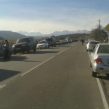
Kabardino-Balkarian Government Policy Failures Raise Ethnic Tensions
Publication: Eurasia Daily Monitor Volume: 10 Issue: 215
By:

Inter-ethnic tensions unexpectedly flared up in Kabardino-Balkaria at the end of November. Residents of the ethnic Balkar–majority town of Belaya Rechka blocked the roads into the town and seized surrounding land to build homes. The republican government, made up mainly of ethnic Kabardinians (a.k.a. Circassians) threatened to use force to reclaim the seized land. At the height of the tensions, Balkar activist Kesaryu Gekkieva told the Kavpolit website: “Currently, about 500 people have gathered, but more people are arriving. Do they [the authorities] want to challenge everybody? Let them send in their tanks. No one will back off” (https://kavpolit.com/belaya-rechka-puti-otrezany/).
The Balkars, a Turkic-speaking ethnic group, comprise about 13 percent of the total population of Kabardino-Balkaria, or some 110,000 people. Ethnic Kabardinians make up about 57 percent of the republican population—around 500,000 people. Ethnic Russians comprise about 23 percent of the population, or some 200,000 people (2010 Russian census results). The conflict between the ethnic Balkars and Kabardinians in Kabardino-Balkaria has been evident for the past several decades. Traditionally, the Balkars live in the mountainous areas of the republic, so business-related disputes brewed around renowned tourist sites near Mount Elbrus. Convoluted legislation about land ownership that does not allow private ownership of land has apparently contributed to the complexity of the issue and increased corruption.
In fact, a Balkar activist, Muradin Rakhaev, asserted that corruption was the main driver of the conflict. “Seeking a Kabardinian-Balkar conflict in this area is pointless,” he said. “But the conflict of interests between the residents of the village (Balkars, Kabardinians, Russians, Cossacks) and the business-bureaucratic clan that is vying for their land is obvious.” While dismissing the idea that the conflict is ethnically based, Rakhaev confirmed in another interview that there are strong ethnic undertones in the standoff. “It must be taken into account that the national question is also present here,” he said. “Khasanya and Belaya Rechka are the two most populous Balkar towns. About 15,000 people reside in them. The future of the entire people [the Balkars] depends on how these two towns develop. It must be said that the state of the Balkars in Kabardino-Balkaria is not enviable. Today we are not represented in the government. Deputies who supposedly represent the Balkars are in fact selected by the republican authorities” (https://kavpolit.com/belaya-rechka-puti-otrezany/).
The towns of Belaya Rechka and Khasanya are suburbs of Nalchik, the capital of Kabardino-Balkaria (https://skfo.ru/reference/city/Belaya_Rechka/). In 2005, they were officially made part of Nalchik, despite protests by the Balkars. Because both suburbs are close to the capital, they seem to offer lucrative opportunities for land speculators. In a likely business-related conflict, the head of the local administration in Khasanya, Ramazan Friev, was gunned down in February 2011 (https://www.kommersant.ru/doc/1589477).
As often happens in ethnic conflicts, the Kabardinians see the problem in a profoundly different light. A Kabardinian activist, Aslan Beshto, asserted that the land of both towns, Belaya Rechka and Khasanya, belonged to the Kabardinians but was seized by the Balkars just before the 1917 revolution. More importantly, Beshto alleged that last summer, the Council of Balkar Elders decreed that the next step for the Balkar people should be joining their ethnic brethren, the Karachays, in neighboring Karachaevo-Cherkessia. The activist expressed fear that if Kabardino-Balkaria were indeed divided up, the borders would follow the borders of municipalities, meaning that ethnic Balkars would gain disproportionately more than the Kabardinians (https://kavpolit.com/sobytiya-v-sele-belaya-rechka-chast-realizacii-plana-po-sozdaniyu-karachaevo-balkarskoj-respubliki/).
Joseph Stalin is often blamed for the peculiar division of ethnic republics in the North Caucasus. The two neighboring republics of Kabardino-Balkaria and Karachaevo-Cherkessia mirror each other in terms of ethnic composition. In Kabardino-Balkaria, the Kabardinians (Circassians) are the majority and the Balkars are the minority. In Karachaevo-Cherkessia, the make-up is reversed: ethnic Cherkess (Circassians) are a minority and ethnic Karachays, who are closely related to the Balkars, are a plurality in the republic. Both Kabardino-Balkaria and Karachaevo-Cherkessia have experienced micro-separatist movements: the Balkars wanted to secede from Kabardino-Balkaria and the Cherkess from Karachaevo-Cherkessia.
Late in President Vladimir Putin’s regime, no movement can change the borders in the North Caucasus without support from Moscow. The 2014 Winter Olympics in Sochi preclude the government from making any decisive changes in the administrative make-up of the North Caucasus. Even after the Olympiad, Moscow may consider the present administrative division of the North Caucasus beneficial, since the Circassians, instead of accusing the Russian state of “genocide,” will have to expend their energy fighting off Balkar aspirations for ever greater land ownership rights. The current limited crisis may well be the result of Moscow encouraging the Balkar leaders and thereby distracting the Circassians from their opposition to the Olympics in Sochi.
Quite separately from Moscow’s interest in dampening the Circassian opposition to the Sochi Olympics, inter-ethnic conflict in the North Caucasus in general, and in Kabardino-Balkaria in particular, may help the Russian government weaken and break up the regional insurgency. Unlike secular activists, the insurgents in Kabardino-Balkaria have displayed a remarkable ability to cut across ethnic division lines: indeed, ethnic Balkars and Kabardinians have succeeded each other as heads of the rebel movement in the past years. Moscow may be hoping that fueling ethnic tensions may be a reliable way to contain the rebel threat in the long run. The process of aggravating ethnic differences also may be a natural phenomenon that reflects the broken mechanisms of conflict resolution given the absence of free elections and avenues for lawful political activities.




